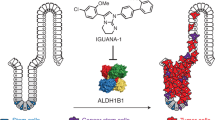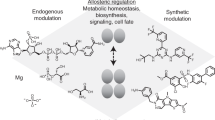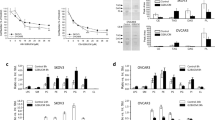Abstract
A hallmark of targeted cancer therapies is selective toxicity among cancer cell lines. We evaluated results from a viability screen of over 200,000 small molecules to identify two chemical series, oxalamides and benzothiazoles, that were selectively toxic at low nanomolar concentrations to the same 4 of 12 human lung cancer cell lines. Sensitive cell lines expressed cytochrome P450 (CYP) 4F11, which metabolized the compounds into irreversible inhibitors of stearoyl CoA desaturase (SCD). SCD is recognized as a promising biological target in cancer and metabolic disease. However, SCD is essential to sebocytes, and accordingly SCD inhibitors cause skin toxicity. Mouse sebocytes did not activate the benzothiazoles or oxalamides into SCD inhibitors, providing a therapeutic window for inhibiting SCD in vivo. We thus offer a strategy to target SCD in cancer by taking advantage of high CYP expression in a subset of tumors.
This is a preview of subscription content, access via your institution
Access options
Subscribe to this journal
Receive 12 print issues and online access
$259.00 per year
only $21.58 per issue
Buy this article
- Purchase on Springer Link
- Instant access to full article PDF
Prices may be subject to local taxes which are calculated during checkout






Similar content being viewed by others
References
Rodriguez-Antona, C. & Ingelman-Sundberg, M. Cytochrome P450 pharmacogenetics and cancer. Oncogene 25, 1679–1691 (2006).
Estabrook, R.W. The remarkable P450s: a historical overview of these versatile hemeprotein catalysts. FASEB J. 10, 202–204 (1996).
Rainov, N.G. et al. New prodrug activation gene therapy for cancer using cytochrome P450 4B1 and 2-aminoanthracene/4-ipomeanol. Hum. Gene Ther. 9, 1261–1273 (1998).
Doloff, J.C. & Waxman, D.J. Adenoviral vectors for prodrug activation-based gene therapy for cancer. Anticancer. Agents Med. Chem. 14, 115–126 (2014).
Rowinsky, E.K. et al. Phase I and pharmacological study of the pulmonary cytotoxin 4-ipomeanol on a single dose schedule in lung cancer patients: hepatotoxicity is dose limiting in humans. Cancer Res. 53, 1794–1801 (1993).
Slaughter, S.R., Statham, C.N., Philpot, R.M. & Boyd, M.R. Covalent binding of metabolites of 4-ipomeanol to rabbit pulmonary and hepatic microsomal proteins and to the enzymes of the pulmonary cytochrome P-450-dependent monooxygenase system. J. Pharmacol. Exp. Ther. 224, 252–257 (1983).
Miyazaki, M. et al. Hepatic stearoyl-CoA desaturase-1 deficiency protects mice from carbohydrate-induced adiposity and hepatic steatosis. Cell Metab. 6, 484–496 (2007).
Merck Sharpe & Dohm Corp. Pharmacokinetics and pharmacodynamics of MK-8245 in participants with type 2 diabetes (MK-8245–012), https://clinicaltrials.gov/ct2/show/results/NCT00972322 (2009).
Ackerman, D. & Simon, M.C. Hypoxia, lipids, and cancer: surviving the harsh tumor microenvironment. Trends Cell Biol. 24, 472–478 (2014).
Paton, C.M. & Ntambi, J.M. Biochemical and physiological function of stearoyl-CoA desaturase. Am. J. Physiol. Endocrinol. Metab. 297, E28–E37 (2009).
Listenberger, L.L. et al. Triglyceride accumulation protects against fatty acid-induced lipotoxicity. Proc. Natl. Acad. Sci. USA 100, 3077–3082 (2003).
Hess, D., Chisholm, J.W. & Igal, R.A. Inhibition of stearoylCoA desaturase activity blocks cell cycle progression and induces programmed cell death in lung cancer cells. PLoS One 5, e11394 (2010).
Scaglia, N. & Igal, R.A. Inhibition of Stearoyl-CoA Desaturase 1 expression in human lung adenocarcinoma cells impairs tumorigenesis. Int. J. Oncol. 33, 839–850 (2008).
Mason, P. et al. SCD1 inhibition causes cancer cell death by depleting mono-unsaturated fatty acids. PLoS One 7, e33823 (2012).
Roongta, U.V. et al. Cancer cell dependence on unsaturated fatty acids implicates stearoyl-CoA desaturase as a target for cancer therapy. Mol. Cancer Res. 9, 1551–1561 (2011).
Zhang, Z., Dales, N.A. & Winther, M.D. Opportunities and challenges in developing stearoyl-coenzyme A desaturase-1 inhibitors as novel therapeutics for human disease. J. Med. Chem. 57, 5039–5056 (2014).
Meingassner, J.G. et al. Pharmacological inhibition of stearoyl CoA desaturase in the skin induces atrophy of the sebaceous glands. J. Invest. Dermatol. 133, 2091–2094 (2013).
Cheng, J.B. & Russell, D.W. Mammalian wax biosynthesis. II. Expression cloning of wax synthase cDNAs encoding a member of the acyltransferase enzyme family. J. Biol. Chem. 279, 37798–37807 (2004).
Kim, H.S. et al. Systematic identification of molecular subtype-selective vulnerabilities in non-small-cell lung cancer. Cell 155, 552–566 (2013).
Ramirez, R.D. et al. Immortalization of human bronchial epithelial cells in the absence of viral oncoproteins. Cancer Res. 64, 9027–9034 (2004).
Kolb, H.C., Finn, M.G. & Sharpless, K.B. Clickc: diverse Chemical function from a few good reactions. Angew. Chem. Int. Ed. Engl. 40, 2004–2021 (2001).
Zhang, L., Ge, L., Parimoo, S., Stenn, K. & Prouty, S.M. Human stearoyl-CoA desaturase: alternative transcripts generated from a single gene by usage of tandem polyadenylation sites. Biochem. J. 340, 255–264 (1999).
Liu, G. et al. Discovery of potent, selective, orally bioavailable stearoyl-CoA desaturase 1 inhibitors. J. Med. Chem. 50, 3086–3100 (2007).
Talamo, B.R. & Bloch, K. A new assay for fatty acid desaturation. Anal. Biochem. 29, 300–304 (1969).
Hukkanen, J., Pelkonen, O., Hakkola, J. & Raunio, H. Expression and regulation of xenobiotic-metabolizing cytochrome P450 (CYP) enzymes in human lung. Crit. Rev. Toxicol. 32, 391–411 (2002).
Leclerc, J. et al. Profiling gene expression of whole cytochrome P450 superfamily in human bronchial and peripheral lung tissues: differential expression in non-small cell lung cancers. Biochimie 92, 292–306 (2010).
Barretina, J. et al. The Cancer Cell Line Encyclopedia enables predictive modelling of anticancer drug sensitivity. Nature 483, 603–607 (2012).
Miyata, N. et al. HET0016, a potent and selective inhibitor of 20-HETE synthesizing enzyme. Br. J. Pharmacol. 133, 325–329 (2001).
Zhang, Z. et al. Discovery of piperazin-1-ylpyridazine-based potent and selective stearoyl-CoA desaturase-1 inhibitors for the treatment of obesity and metabolic syndrome. J. Med. Chem. 56, 568–583 (2013).
Cerami, E. et al. The cBio cancer genomics portal: an open platform for exploring multidimensional cancer genomics data. Cancer Discov. 2, 401–404 (2012).
Flowers, M.T., Ade, L., Strable, M.S. & Ntambi, J.M. Combined deletion of SCD1 from adipose tissue and liver does not protect mice from obesity. J. Lipid Res. 53, 1646–1653 (2012).
Dhar, M., Sepkovic, D.W., Hirani, V., Magnusson, R.P. & Lasker, J.M. Omega oxidation of 3-hydroxy fatty acids by the human CYP4F gene subfamily enzyme CYP4F11. J. Lipid Res. 49, 612–624 (2008).
Shanklin, J., Guy, J.E., Mishra, G. & Lindqvist, Y. Desaturases: emerging models for understanding functional diversification of diiron-containing enzymes. J. Biol. Chem. 284, 18559–18563 (2009).
Fox, B.G., Lyle, K.S. & Rogge, C.E. Reactions of the diiron enzyme stearoyl-acyl carrier protein desaturase. Acc. Chem. Res. 37, 421–429 (2004).
Hardwick, J.P. Cytochrome P450 omega hydroxylase (CYP4) function in fatty acid metabolism and metabolic diseases. Biochem. Pharmacol. 75, 2263–2275 (2008).
Wang, H. et al. Crystal structure of human stearoyl-coenzyme A desaturase in complex with substrate. Nat. Struct. Mol. Biol. 22, 581–585 (2015).
Bai, Y. et al. X-ray structure of a mammalian stearoyl-CoA desaturase. Nature 524, 252–256 (2015).
Trudgian, D.C. et al. CPFP: a central proteomics facilities pipeline. Bioinformatics 26, 1131–1132 (2010).
Craig, R. & Beavis, R.C. TANDEM: matching proteins with tandem mass spectra. Bioinformatics 20, 1466–1467 (2004).
Geer, L.Y. et al. Open mass spectrometry search algorithm. J. Proteome Res. 3, 958–964 (2004).
Elias, J.E. & Gygi, S.P. Target-decoy search strategy for increased confidence in large-scale protein identifications by mass spectrometry. Nat. Methods 4, 207–214 (2007).
Quehenberger, O., Armando, A.M. & Dennis, E.A. High sensitivity quantitative lipidomics analysis of fatty acids in biological samples by gas chromatography-mass spectrometry. Biochim. Biophys. Acta 1811, 648–656 (2011).
Morselli, E. et al. Hypothalamic PGC-1α protects against high-fat diet exposure by regulating ERα. Cell Rep. 9, 633–645 (2014).
Moffat, J. et al. A lentiviral RNAi library for human and mouse genes applied to an arrayed viral high-content screen. Cell 124, 1283–1298 (2006).
McNaney, C.A. et al. An automated liquid chromatography-mass spectrometry process to determine metabolic stability half-life and intrinsic clearance of drug candidates by substrate depletion. Assay Drug Dev. Technol. 6, 121–129 (2008).
Sheehan, D.C. Theory and Practice of Histotechnology 2 edn. (Battelle Press, 1980).
Woods, A.E. & Ellis, R.C. Laboratory Histopathology, A Complete Reference (Churchill-Livingston, 1996).
Acknowledgements
We thank S. Yadavalli and D.C. Trudgian for advice on proteomics, D.W. Russell for guidance on biochemical assays of sebaceous glands and preputial gland dissection, J.G. McDonald and M. Mitsche for advice on fatty acid flux analyses, and S.L. McKnight for helpful discussions and suggestions on the manuscript. C.R.-N. acknowledges the Clayton Foundation for Research and US National Institutes of Health grant HL20948 for support. H.M. acknowledges the Cancer Prevention Research Institute of Texas (CPRIT; RP120613) for funding. B.A.P. acknowledges the Simmons Cancer Center (National Cancer Institute 1P30CA142543-01), CPRIT (RP110708-C2) and CTD2 (1 U01 CA176284-01) for funding. N.S.W. acknowledges CPRIT (RP110708-C3) for funding. J.M.R. acknowledges CPRIT (RP110708-P3) and the Welch Foundation (I-1612) for funding. D.N. acknowledges the Disease Oriented Clinical Scholar (DOCS) award, the Presidential Research Council (PRC) award, the Welch Foundation (I-1879) and the Damon Runyon Clinical Investigator Award (CI-68-13).
Author information
Authors and Affiliations
Contributions
P.C.T. designed and performed target identification, compound selectivity, compound toxicity studies and wrote the manuscript; S.S.G. synthesized all of the benzothiazoles in the optimization that led to SW203668, Xenon-45, Alexa Fluor dye azide and dMe-SW208108; S.E.W. synthesized all of the oxalamides in the optimization that led to SW208108; C.R.-N. performed fatty acid flux analysis; J.S.M. performed molecular cloning; L.K.M., J.M.H. and B.C. performed pharmacokinetic and compound metabolism studies; A.E.O. and Y.D. assisted with compound concentration response studies; J.R.M. synthesized SW209049; A.L. and H.M. performed protein mass spectrometry; B.A.P. developed and used the S-Score analysis to identify potential selective toxins and performed unsupervised hierarchical clustering; N.S.W. designed, performed and supervised xenograft, pharmocokinetic, compound metabolism and compound toxicity studies; J.M.R. designed and supervised chemical synthetic strategies, target identification and compound toxicity studies; D.N. designed and supervised target identification, compound selectivity and compound toxicity studies, and wrote the manuscript.
Corresponding authors
Ethics declarations
Competing interests
The authors declare no competing financial interests.
Supplementary information
Supplementary Text and Figures
Supplementary Results, Supplementary Tables 1–5, Supplementary Figures 1–6 and Supplementary Note (Synthetic Procedures) (PDF 19570 kb)
Supplementary Data Set 1
Calculation of S scores from the viability of 12 different NSCLC cell lines and HBEC30KT cell line after treatment with 15,483 small molecules. (XLSX 2277 kb)
Supplementary Data Set 2
520 small molecules with chemical structure with accompanying toxicity data in 12 NSCLC cell lines and HBEC30KT along with S scores. (XLSX 3190 kb)
Supplementary Data Set 3
Tandem mass spectrometry results from p37 and p30 excised bands. (XLSX 69 kb)
Rights and permissions
About this article
Cite this article
Theodoropoulos, P., Gonzales, S., Winterton, S. et al. Discovery of tumor-specific irreversible inhibitors of stearoyl CoA desaturase. Nat Chem Biol 12, 218–225 (2016). https://doi.org/10.1038/nchembio.2016
Received:
Accepted:
Published:
Issue Date:
DOI: https://doi.org/10.1038/nchembio.2016
This article is cited by
-
Target identification of small molecules: an overview of the current applications in drug discovery
BMC Biotechnology (2023)
-
Advances in regulation and function of stearoyl-CoA desaturase 1 in cancer, from bench to bed
Science China Life Sciences (2023)
-
Stearoyl-CoA desaturase 1 as a therapeutic target for cancer: a focus on hepatocellular carcinoma
Molecular Biology Reports (2022)
-
PI(18:1/18:1) is a SCD1-derived lipokine that limits stress signaling
Nature Communications (2022)
-
SCD1, autophagy and cancer: implications for therapy
Journal of Experimental & Clinical Cancer Research (2021)



